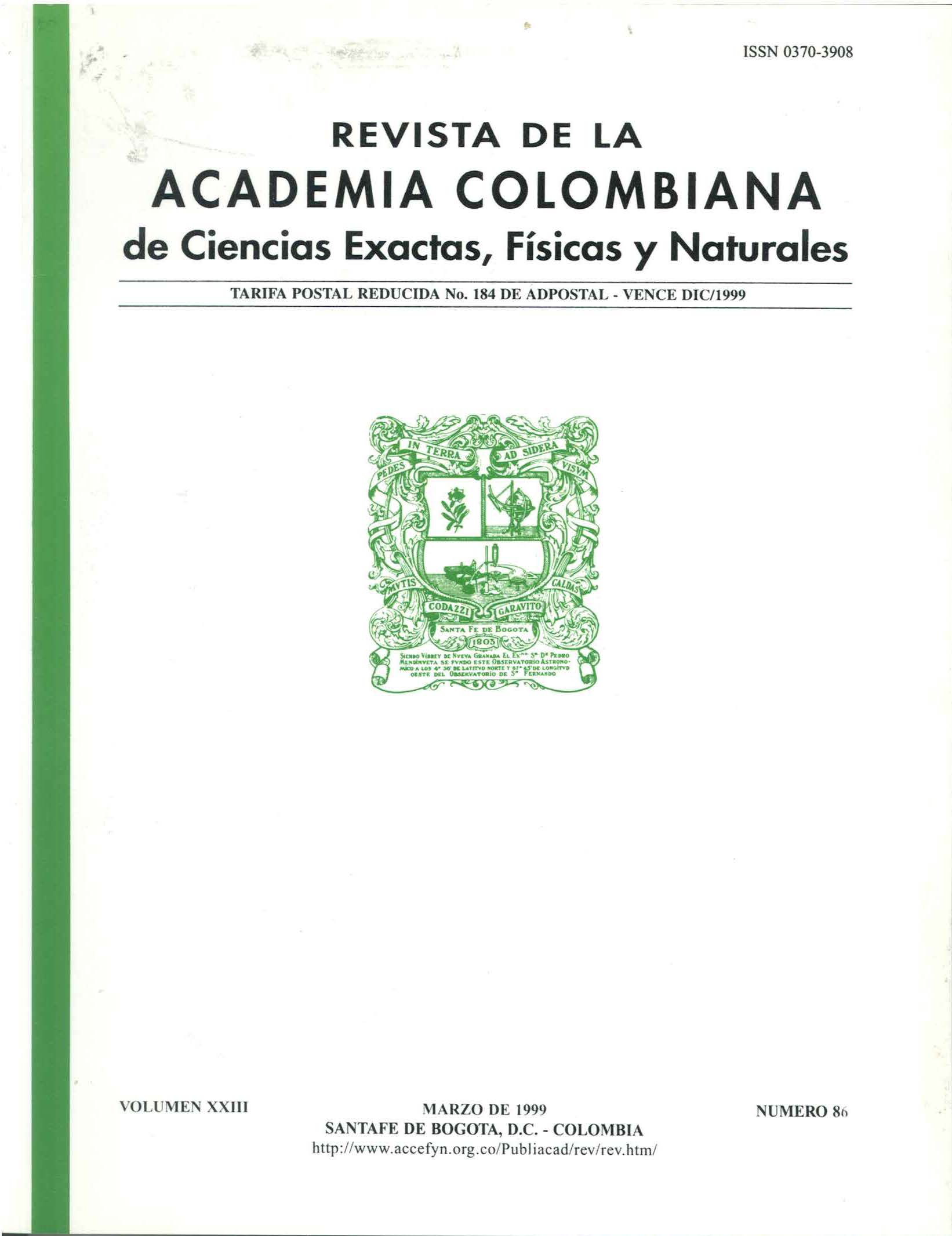Resumen
Durante el primer semestre de 1994, estudiamos 30 machos y 40 posturas de Cochranella ignota en un bosque de niebla a 1900 msnm en la Cordillera Occidental. El agrupamiento de los machos en sitios restringidos y la regularidad en su distribución dentro de cada agregado sugieren territorialidad y selección de sitios de despliegue. La ausencia de patrones en las variables estructurales de hábitat de despliegue y de desove sugiere mecanismos puramente conductuales para la escogencia de parejas. La comparación de la reproducción de esta población con la de otras especies de anfibios anuros revela un sistema tipo Lek.
Referencias
Arak, A. 1983. Male male competition and mate choice in anuran amphibians. pp.181-210. In: Bateson, P. (ed.): Mate Choice. Cambridge University Press: Cambridge.
Crump, M. L. 1974. Reproductive strategies in a tropical anuran community. Univ. Kansas Mus. Nat. Hist. Misc. Publ. (61):1-68.
Duellman, W. E. 1992. Estrategias reproductoras de las ranas. Investigación y Ciencia (192):54-62.
Duellman, W. E. & A. H. Savitzky. 1976. Aggressive behavior in a Centrolenid frog, with comments on territoriality in Anurans. Herpetologica 32:401-404.
Duellman, W. E. & L. Trueb. 1986. Biology of Amphibians. McGrawHill, Inc.: New York.
Elliot, 1983. Some Methods for the Statitical Analysis of Samples of Benthic Invertebrates. 2 edición. Freshwater Biol. Assoc., Scient. Public. (25):1-157.
Emlen, S. T. 1976. Lek organization and mating strategy in the bullfrog. Behav. Ecol. Sociobiol. 1:283-313.
Emlen, S. T. & L. W. Oring. 1977. Ecology, sexual selection, and the evolution of mating systems. Science. 197:215-223.
Ferner, J. W. 1979. A review of marking techniques for amphibians and reptiles. Herpetological Circular (9); i-vi+1-41.
Greer, B. J. & K. D. Wells. 1980. Territorial and Reproductive Behavior of the Tropical American Frog Centrolenella fleischmanni. Herpetologica. 36:318-326.
Halliday, T. R. 1981. Sexual Selection and Mate Choice, pp. 180-213. In: Krebs J. R. & N. B. Davies (eds.): Behavioural Ecology. An Evolutionary Approach. Sinauer Associates, Inc.: Sunderland, Massachusetts.
Hintze. J. L. 1987. Number Cruncher Statistical System (NCSS). Kaysville, Utah.
Howard, R. D. 1978. The evolution of mating strategies in bullfrog. Rana cutesheiana. Evolution 32:850-871.
IGAC (Instituto Geográfico Agustin Codazzi). 1977. Mapa Ecológico. Bogotá.
Jacobson, S. K. 1985. Reproductive behavior and male mating success in two species of Glass Frogs (Centrolenidae). Herpetologica. 41:396-404.
Ludwig, J. A. & J. F. Reynolds. 1988. Statistical Ecology: A Primer on Methods and Computing. John Wiley & Sons: New York.
Lynch, J. D. 1979. The amphibians of the lowland tropical forest. pp. 189. 215. In: Duellman, W. E. (ed.): The South American Herpetofauna: Its Origin. Evolution, and Dispersal. Monogr. Mus. Nat. Hist. Univ. Kansas (7):1-485.
Lynch, J. D., P. M. Ruiz-C & J. V. Rueda-A. 1983. Notes on the distribution and reproduction biology of Centrolene geckoideum Jiménez de la
Espada in Colombia and Ecuador (Amphibia: Centrolenidae). Stud. Neotrop. Fauna Environ. (18):239-243.
McDiarmid, R. K. 1975. Glass frog romance along a tropical stream. Terra. Los Angeles County Museum.13:14-18.
McDiarmid, R. K. & K. Adler. 1974. Notes on territorial and vocal behavior of neotropical frogs of the genus Centrolenella. Herpetologica.30:75-78.
Orians, G. H. 1969. On the evolution of mating systems in birds and mammals. Amer. Natur. 103:589-603.
Rueda A., J. V. 1994. Estudio anatómico y relaciones sistemáticas de Centrolene geckoideum (Salientia: Anura: Centrolenidae). Trianca. 5:133-187.
Ruiz-C., P. M. & J. D. Lynch. 1991. Ranas Centrolenidas de Colombia. I. Propuesta de una nueva clasificación genérica. Lozania. (57):1-30.
Villa, J. 1984. Biology of a Neotropical Glass Frog. Centrolenella fleischmanni (Boettger), with special reference to its frogfly associates. Milwaukee Public Mus. Contrib. Biol. Geol. (55):1-60.
Weatherhead, P. J. & R. J. Robertson. 1979. Offspring quality and the polygyny threshold: "the sexy son hypothesis". Amer. Natur. 113:201-208.
Weatherhead, P. J. & R. J. Robertson. 1981. In defense of the "sexyson" hypothesis. Amer. Natur. 117: 349-356.
Zar, J. H. 1984. Biostatistical Analysis. Prentice Hall: Englewood Cliffs. New Jersey.

Esta obra está bajo una licencia internacional Creative Commons Atribución-NoComercial-SinDerivadas 4.0.
Derechos de autor 2024 Revista de la Academia Colombiana de Ciencias Exactas, Físicas y Naturales

